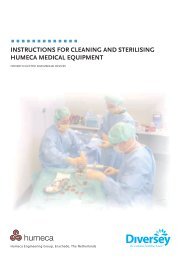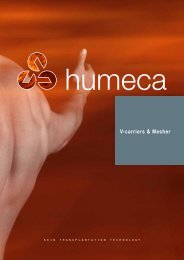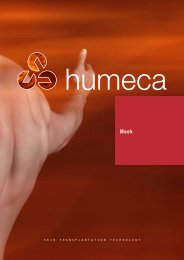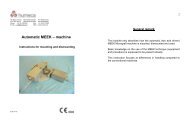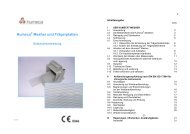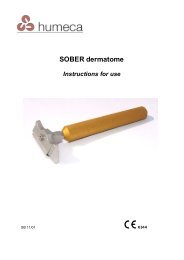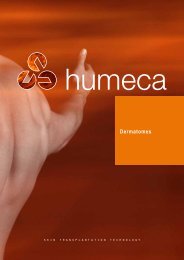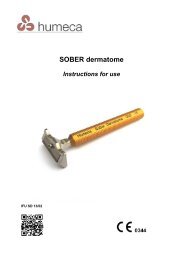General company brochure with info of all products - Humeca
General company brochure with info of all products - Humeca
General company brochure with info of all products - Humeca
Create successful ePaper yourself
Turn your PDF publications into a flip-book with our unique Google optimized e-Paper software.
Motor driven MEEK machine –<br />
automatic version <strong>with</strong> two motors<br />
meek features<br />
• Very sm<strong>all</strong> donorsites<br />
• Large expansion ratios (up to 1:9) possible<br />
• Any sm<strong>all</strong> skin fragments can be used; no long strips required<br />
• Graft islands are close together in a regular pattern, resulting in fast and uniform epithelialization<br />
• All graft islands are correctly orientated (dermal side down) on the wound bed, resulting in excellent graft take<br />
• Failure <strong>of</strong> a few islands does not affect the over<strong>all</strong> graft take<br />
• Actual expansion ratio equals theoretical expansion ratio<br />
• Cosmetic results are comparable <strong>with</strong> meshgrafts <strong>of</strong> a lower expansion<br />
• Grafts adhere to a fabric and are therefore very easy to manipulate when applying them to the wound<br />
meek literature<br />
1 Meek CP, Successful microdermagrafting using the Meek-W<strong>all</strong> microdermatome – Am. Surg. vol. 29, pp. 61 (1958)<br />
2 Meek CP, Extensive severe burn treated <strong>with</strong> enzymatic debridement and microdermagrafting – American Surgeon, vol. 29, no. 1, pp. 61-64 (1963)<br />
3 Kreis RW, Mackie DP, Vloemans AWFP, Hermans RP, Hoekstra MJ, Widely expanded postage stamp skin grafts using a modified Meek technique in combination <strong>with</strong> an <strong>all</strong>ograft overlay –<br />
Burns, vol. 19 (2), pp. 142-145 (1993)<br />
4 Kreis RW, Mackie DP, Hermans RP, Vloemans AWFP, Expansion techniques for skin grafts: comparison between mesh and Meek island (sandwich-)grafts – Burns, vol. 20 (1), pp. S39-S42 (1994)<br />
5 Peeters R, Hubens A, The mesh skin graft – true expansion rate – Burns, vol. 14 (3), pp. 239-240 (1988)<br />
6 Raff T, Hartmann B, Wagner H, Germann G, Experience <strong>with</strong> the modified MEEK technique – Acta Chirurgiae Plasticae, vol. 38 (4) pp. 142-146 (1996)<br />
7 Zermani Rita, Zarabini Andrea, Trivisonno Angelo, Micrografting in the treatment <strong>of</strong> severely burned patients – Burns, vol. 23 (7/8), pp. 604-607 (1997)<br />
8 Hermans RP, Kreis R, Micrografting – Revival <strong>of</strong> an old technique – Annals <strong>of</strong> Burns and Fire Disasters, vol. 10 (1) (1997)<br />
9 Vloemans AFPM, Micrografts versus Meshgrafts – Casus<br />
10 Hadjiiski O, Method <strong>of</strong> micrografting in treatment <strong>of</strong> large area full-thickness burns – Annals <strong>of</strong> Burns and Fire Disasters, vol. 13 (3), pp. 155-158 (2000)<br />
11 Lari AR, Gang RK, Expansion technique for skin grafts (Meek technique) in the treatment <strong>of</strong> severely burned patients – Burns, vol. 27, pp. 61-66 (2001)<br />
12 Grenier de Cardenal D, Bey E, Lambert F, Duhamel P, Chaine A, Giraud O, Cantaloube D, Le procédé <strong>Humeca</strong> chez le grand brûlé: Difficultés – Brûlures, vol. III (1), pp. 34-37 (2002)<br />
13 Papp A, Härmä M, Case report: A collagen based dermal substitue and the modified Meek technique in extensive burns – Report <strong>of</strong> three cases – Burns 29, pp. 167-171 (2003)<br />
14 Kopp J, Noah EM, Rübben A, Merk HF, P<strong>all</strong>ua N, Radical resection <strong>of</strong> giant congenital melanocytic nevus and reconstruction <strong>with</strong> Meek-graft covered Integra dermal template –<br />
Dermatologic Surgery vol. 29 (6) pp. 653-657 (2003)<br />
15 Tempelman FRH, Meek Micrografting – abstract lecture<br />
16 Tempelman FRH, Vloemans AFPM, Middelkoop E, Kreis RW., The Meek-W<strong>all</strong> Micrograft Technique. In: Surgery in Wounds, Téot L, Banwell PE, Ziegler UE, eds. Springer-Verlag Berlin Heidelberg,<br />
pp.427-434, (2004), (ISBN 3-540-22254-5, ed. 2005)<br />
17 GE Sheng-de, History <strong>of</strong> the clinic work about MEEK – Chinese Journal <strong>of</strong> Injury Repair and Wound Healing, vol. 1 (1) pp. 10-11 (2006)<br />
18 LIN Cai, CHEN Geng-xin, ZHANG Peng, et al., The MEEK technology <strong>of</strong> tiny flap graft using on extensively and deeply burning – Chinese Journal <strong>of</strong> Injury Repair and Wound Healing,<br />
vol. 1 (1) pp. 24-26 (2006)<br />
19 YANG Ding-wen, TAN Qian, WU Jie, et al., Comparison between the MEEK’s autograft and the stamp-like autograft in the clinical application –<br />
Chinese Journal <strong>of</strong> Injury Repair and Wound Healing, vol. 1 (1) pp. 30-33 (2006)<br />
20 SUN Yong-hua, ZHANG Ming-liang, ZHOU Yi-ping, et al., Transplantation <strong>of</strong> microskin Autografts and skin pulp auto-epithelium and homeoderma in the treatment <strong>of</strong> extensive full-thickness burns –<br />
Chinese Journal <strong>of</strong> Injury Repair and Wound Healing, vol. 2 (1) pp. 10-13 (2007)<br />
21 YE, Sheng-jie, PANG Shu-guang, AZHANG Wen-zhen, et al., Application experience <strong>of</strong> MEEK Skin-piece making technique on large area deep burning –<br />
Chinese Journal <strong>of</strong> Injury Repair and Wound Healing, vol. 2 (1) pp. 10-13 (2007)<br />
22 SUN, Dong-yuan, ZHANG, Hua-bin, CHEN Ji-yang, et al., Repairing <strong>of</strong> the residual wounds in major burn patients <strong>with</strong> Meek skin grafting technique –<br />
Chinese Journal <strong>of</strong> Injury Repair and Wound Healing, vol. 2 (2) pp. 113-114 (2007)<br />
23 Chun-Sheng Hsieh, Jen-Yu Schuong, W.S. Huang, Ted T. Huang, Five years’ experience <strong>of</strong> the modified Meek technique in the management <strong>of</strong> extensive burns – Burns, vol. 34, pp. 350-354 (2008)<br />
24 Lumenta DB, Kamolz LP, Frey M., Adult burn patients <strong>with</strong> more than 60% TBSA involved – MEEK and other techniques to overcome restricted skin harvest availability –<br />
The Viennese Concept – Journal <strong>of</strong> Burn Care & Research, March/April, pp. 231-242 (2009)<br />
25 S.E. James, S. Booth, P.M. Gilbert et. Al., Sprayed cultured autologous keratinocytes used alone or in combination <strong>with</strong> meshed autografts to accelerate wound closure in difficult-to-heal burns patients –<br />
Burns vol. 36, pp e10-e20 (2010).<br />
9



